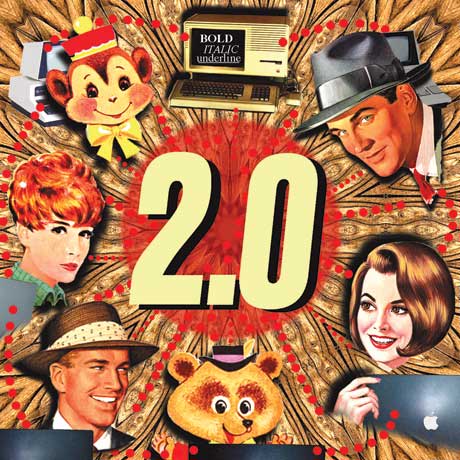This isn't 1983, so why am I excited about a word processor? This cornerstone of our digital lives is something I really don't notice anymore like binary flowers on a walk you've taken one too many times, a word processor is background. Yet, I am excited to see all the familiar elements: Bold, Italic, Underline, theyre all here and they even work with the command keys. The reason why Im so jazzed is because I am not working on a file on my computer; I didnt launch an application from my start bar. I clicked a url. I'm saving to some anonymous server farm flipping petabytes like bits were beef. I am using Googles Docs & Spreadsheets. Its the simplest idea, transferring an office suite from desktop to the internet. Yet this could have a devastating effect on the software industry. It could be Web 2.0s coming of age and the end of the desktop era.
Back in 2004, Web 2.0 became the idea of the moment. Tim O'Reily, famed for computer manuals that bear his name, and John Battelle, a respect tech journalist, defined the 2.0 idea. They started with the concept of the web as computer; that is, software applications and the processing and storing of files would all done by distant servers, as gmail or hotmail do with email. Since a 2.0 site would control the data over a network, it would be collaborative in nature anyone can share their digital creation with their friends by inviting them to see it. Software applications are then in a perpetual state of beta, with new features added and refined on the fly.
Web 2.0 has become possible because of a new web development technique called Ajax or Asynchronous JavaScript and XML. This process allows for small elements of data to be loaded as necessary and reloaded without refreshing. Instead of waiting for the entire page to reload when you click to enlarge a photo or edit some text, the edited item is refreshed immediately or an icon appears (like the Window's hourglass and Macs pinwheel beach ball) for a short time as only the changed element is loaded or saved. Quick to load and seamless in appearance, Web 2.0 programs appear to be just like their desktop kin.
The fruits of this intellectual salad have already blossomed. Sites like MySpace, Flickr, and del.icio.us are archetypes of the principals of Web 2.0. They are an amalgamation of tools web editor, file uploader and messaging systems used to create new social activities. A site like MySpace offers a collaborative community that is constantly rebuilding its social structure to follow the latest trend.
If productivity was the end goal as is the case with Docs & Spreadsheets advantages are obvious. Users can invite people to collaborate and can specify viewing and editing permission. Leaving text and spreadsheets on the web speeds up and makes non-linear the collaborative process. (Googles product shows how many people are currently working on the same doc, potentially up to 50).
Instant collaboration may put Google one attribute ahead of their competition, though on a feature-by-feature basis, D&S remains significantly behind Microsoft products like Word and Excel. But price tag is no comparison: Microsofts proprietary software costs hundreds of dollars, with upgrades every few years; Google seeks nothing more than brand loyalty. Next year, Microsoft launches a massive Office update, likely with as many bugs as fancy new bells. Since D&S is in perpetual beta, it circumvents the update cycle and can creep along, adding new features one at a time, while a virtual world of users serves as its team of beta testers. Docs & Spreadsheets will evolve and improve as it works, something that terrifies Microsoft.
Microsoft is not the only one who should be scared. This is a slippery slope that could change the course of computing forever. Software like D&S and others (see sidebar) are not likely to eliminate professional apps like Photoshop or Final Cut huge file requirements and processing speeds they demand will not be met by net apps in the near future. However, 2.0 applications will easily meet the needs of the average consumer and business user. Software piracy may prove to be a paltry problem in comparison to the major menace Web 2.0 will be for the application industry. Manufacturers used to marketing version 5.1 may have to drop their "new and improved sell cycle and turn to a subscription system for revenue or, stranger still, an advertising model.
Beyond software shake-ups is the very form our computer takes. It's easy to get rhetorical imagining the future: If you can store your documents online do you need a huge hard drive? If you only need to run one application do you need hunk of ram? If most of the processing is done by a server far away do you need a powerhouse computer? If all you need is a browser say, a free, open source browser like Firefox do you need an operating system with all the amenities like Windows or Mac Os? Can't I just do my computing on whatever happens to be around: my television, my cell phone, my PSP?
It's the end of '06 and I am so excited about a word processor that I've just typed my article on it.
Other 2.0 Desktop Replacements
Ajax13(ajax13.com)
Talk about wearing your programming on your sleeve. This nerdily named office suite with a word processor (ajaxWrite), spreadsheet (ajaxXLS), drawing program (ajaxSketch), presentation software (ajaxPresents) and even a media player like iTunes, aptly called ajaxTunes. Although, it has a much more convincing look and feel a file menu at the top of the window, a familiar grey toolbar it is lacking some essential features like spell check and the ability to edit spreadsheets.
Jumpcut(jumpcut.com)
As a video editor Jumpcut the online cousin of movie cutting for the masses programs like iMovie or Sonys Vegas is the simplest ever to use. It's quite an achievement to have made such an efficient interface for a complex task. Still, it doesnt answer the question of why you would upload before you edit since most importing of digital video is done though an editor. Luckily there are some uploaded, royalty free videos or "open movies" so even if you don't have a camera you can still live out your dreams of being Thelma Schoonmaker.
Slice(splicemusic.com)
Slice is a music sequencer with ethics. Launching with all users having to subscribe to the Creative Commons license for anything they upload essential an agreement saying "sample this royalty free but make sure to give credit to me Slice gets the "most likely to foster a community award. Loops and songs can be arranged, uploaded, borrowed, and remixed, making this site a mash-up heaven and is sure to end up in "what the hell did you do to my track?!" flame wars.
Back in 2004, Web 2.0 became the idea of the moment. Tim O'Reily, famed for computer manuals that bear his name, and John Battelle, a respect tech journalist, defined the 2.0 idea. They started with the concept of the web as computer; that is, software applications and the processing and storing of files would all done by distant servers, as gmail or hotmail do with email. Since a 2.0 site would control the data over a network, it would be collaborative in nature anyone can share their digital creation with their friends by inviting them to see it. Software applications are then in a perpetual state of beta, with new features added and refined on the fly.
Web 2.0 has become possible because of a new web development technique called Ajax or Asynchronous JavaScript and XML. This process allows for small elements of data to be loaded as necessary and reloaded without refreshing. Instead of waiting for the entire page to reload when you click to enlarge a photo or edit some text, the edited item is refreshed immediately or an icon appears (like the Window's hourglass and Macs pinwheel beach ball) for a short time as only the changed element is loaded or saved. Quick to load and seamless in appearance, Web 2.0 programs appear to be just like their desktop kin.
The fruits of this intellectual salad have already blossomed. Sites like MySpace, Flickr, and del.icio.us are archetypes of the principals of Web 2.0. They are an amalgamation of tools web editor, file uploader and messaging systems used to create new social activities. A site like MySpace offers a collaborative community that is constantly rebuilding its social structure to follow the latest trend.
If productivity was the end goal as is the case with Docs & Spreadsheets advantages are obvious. Users can invite people to collaborate and can specify viewing and editing permission. Leaving text and spreadsheets on the web speeds up and makes non-linear the collaborative process. (Googles product shows how many people are currently working on the same doc, potentially up to 50).
Instant collaboration may put Google one attribute ahead of their competition, though on a feature-by-feature basis, D&S remains significantly behind Microsoft products like Word and Excel. But price tag is no comparison: Microsofts proprietary software costs hundreds of dollars, with upgrades every few years; Google seeks nothing more than brand loyalty. Next year, Microsoft launches a massive Office update, likely with as many bugs as fancy new bells. Since D&S is in perpetual beta, it circumvents the update cycle and can creep along, adding new features one at a time, while a virtual world of users serves as its team of beta testers. Docs & Spreadsheets will evolve and improve as it works, something that terrifies Microsoft.
Microsoft is not the only one who should be scared. This is a slippery slope that could change the course of computing forever. Software like D&S and others (see sidebar) are not likely to eliminate professional apps like Photoshop or Final Cut huge file requirements and processing speeds they demand will not be met by net apps in the near future. However, 2.0 applications will easily meet the needs of the average consumer and business user. Software piracy may prove to be a paltry problem in comparison to the major menace Web 2.0 will be for the application industry. Manufacturers used to marketing version 5.1 may have to drop their "new and improved sell cycle and turn to a subscription system for revenue or, stranger still, an advertising model.
Beyond software shake-ups is the very form our computer takes. It's easy to get rhetorical imagining the future: If you can store your documents online do you need a huge hard drive? If you only need to run one application do you need hunk of ram? If most of the processing is done by a server far away do you need a powerhouse computer? If all you need is a browser say, a free, open source browser like Firefox do you need an operating system with all the amenities like Windows or Mac Os? Can't I just do my computing on whatever happens to be around: my television, my cell phone, my PSP?
It's the end of '06 and I am so excited about a word processor that I've just typed my article on it.
Other 2.0 Desktop Replacements
Ajax13(ajax13.com)
Talk about wearing your programming on your sleeve. This nerdily named office suite with a word processor (ajaxWrite), spreadsheet (ajaxXLS), drawing program (ajaxSketch), presentation software (ajaxPresents) and even a media player like iTunes, aptly called ajaxTunes. Although, it has a much more convincing look and feel a file menu at the top of the window, a familiar grey toolbar it is lacking some essential features like spell check and the ability to edit spreadsheets.
Jumpcut(jumpcut.com)
As a video editor Jumpcut the online cousin of movie cutting for the masses programs like iMovie or Sonys Vegas is the simplest ever to use. It's quite an achievement to have made such an efficient interface for a complex task. Still, it doesnt answer the question of why you would upload before you edit since most importing of digital video is done though an editor. Luckily there are some uploaded, royalty free videos or "open movies" so even if you don't have a camera you can still live out your dreams of being Thelma Schoonmaker.
Slice(splicemusic.com)
Slice is a music sequencer with ethics. Launching with all users having to subscribe to the Creative Commons license for anything they upload essential an agreement saying "sample this royalty free but make sure to give credit to me Slice gets the "most likely to foster a community award. Loops and songs can be arranged, uploaded, borrowed, and remixed, making this site a mash-up heaven and is sure to end up in "what the hell did you do to my track?!" flame wars.




